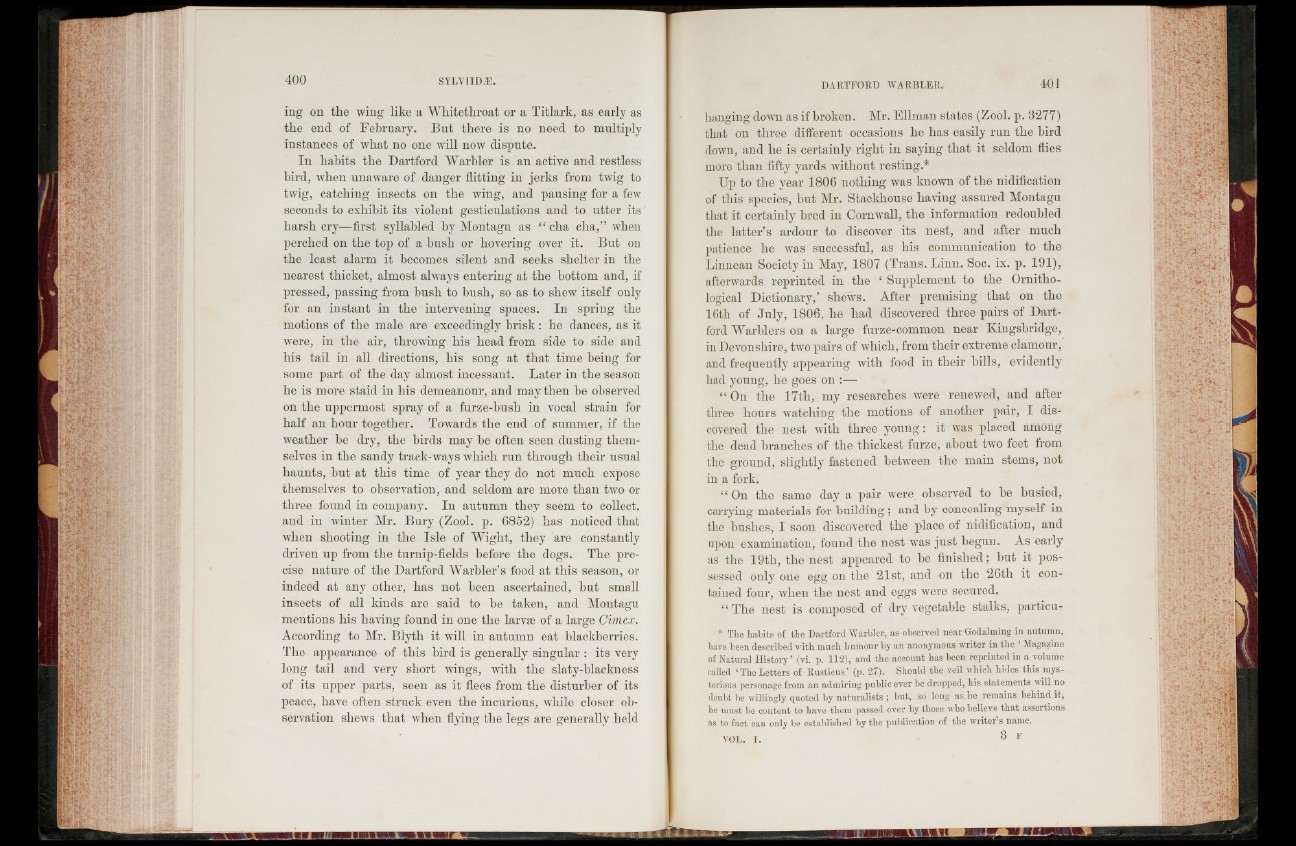
ing on the wing like a Whitethroat or a Titlark, as early as
the end of February. But there is 110 need to multiply
instances of what no one will now dispute.
In habits the Dartford Warbler is an active and restless
bird, when unaware of danger flitting in jerks from twig to
twig, catching insects on the wing, and pausing for a few
seconds to exhibit its violent gesticulations and to utter its
harsh cry—first syllabled by Montagu as “ cha clia,” when
perched 011 the top of a bush or hovering over it. But 011
the least alarm it becomes silent and seeks shelter in the
nearest thicket, almost always entering at the bottom and, if
pressed, passing from bush to bush, so as to shew itself only
for an instant in the intervening spaces. In spring the
motions of the male are exceedingly b risk : he dances, as it
were, in the air, throwing his head from side to side and
his tail in all directions, his song at that time being for
some part of the day almost incessant. Later in the season
he is more staid in his demeanour, and may then be observed
on the uppermost spray of a furze-bush in vocal strain for
half an hour together. Towards the end of summer, if the
weather be dry, the birds may be often seen dusting themselves
in the sandy track-ways which run through their usual
haunts, but at this time of year they do not much expose
themselves to observation, and seldom are more than two or
three found in company. I 11 autumn they seem to collect,
and in winter Mr. Bury (Zool. p. 6852) has noticed that
when shooting in the Isle of Wight, they are constantly
driven up from the turnip-fields before the dogs. The precise
nature of the Dartford Warbler’s food at this season, or
indeed at any other, has not been ascertained, but small
insects of all kinds are said to be taken, and Montagu
mentions his having found in one the larvae of a large Cimex.
According to Mr. Biytli it will in autumn eat blackberries.
The appearance of this bird is generally singular : its very
long tail and very short wings, with the slaty-blackness
of its upper parts, seen as it flees from the disturber of its
peace, have often struck even the incurious, while closer observation
shews that when flying the legs are generally held
hanging down as if broken. Mr. Ellman states (Zool. p. 8277)
that on three different occasions he has easily run the bird
down, and he is certainly right in saying that it seldom flies
more than fifty yards without resting.*
Up to the year 1806 nothing was known of the nidification
of this species, but Mr. Stackhouse having assured Montagu
that it certainly bred in Cornwall, the information redoubled
the latter’s ardour to discover its nest, and after much
patience he was successful, as his communication to the
Linnean Society in May, 1807 (Trans. Linn. Soc. ix. p. 191),
afterwards reprinted in the ‘ Supplement to the Ornithological
Dictionary,’ shews. After premising that on the
16tli of July, 1806, he had discovered three pairs of Dartford
Warblers on a large furze-common near Kingsbridge,
in Devonshire, two pairs of which, from their extreme clamour,
and frequently appearing with food in their bills, evidently
had young, he goes on :—
“ On the 17tli, my researches were renewed, and after
three hours watching the motions of another pair, I discovered
the nest with three young: it was placed among
the dead branches of the thickest furze, about two feet from
the ground, slightly fastened between the main stems, not
in a fork.
“ On the same day a pair were observed to be busied,
carrying materials for building; and by concealing myself in
the bushes, I soon discovered the place of nidification, and
upon examination, found the nest was just begun. As early
as the 19tli, the nest appeared to be finished; but it possessed
only one egg on the 21st, and on the 26tli it contained
four, when the nest and eggs were secured.
“ The nest is composed of dry vegetable stalks, particu-
* The habits of the Dartford Warbler, as observed near Hodalming in autumn,
have been described with much humour by an anonymous writer in the ‘ Magazine
of Natural History’ (vi. p. 112), and the account has been reprinted in a volume
called ‘TheLetters of Rusticus’ (p. 27). Should the veil which hides this mysterious
personage from an admiring public ever be dropj>ed, his statements will no
doubt be willingly quoted by naturalists ; but, so long as he remains behind it,
be must be content to have them passed over by those who believe that assertions
as to fact can only be established by the publication of the writer’s name.
VOL. I . 3 F